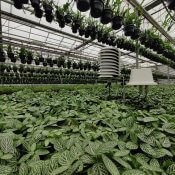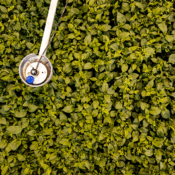Autonomous growing is no longer a far-fetched dream
The Autonomous Greenhouse Challenge has come to an end and we made it to the finish line. Our multidisciplinary team of horticultural experts and computer scientists from Delphy and 30MHz grew healthy cherry tomatoes remotely in 6 month’s time. In this period, we were able to develop the system and models needed to control a greenhouse remotely.
This morning, the jury announced the winner and gave feedback on how team The Automators performed. “With an ambitious strategy, this team applied a realtime data model using additional data sources such as sap flow sensors. Their realistic approach includes a step by step process in which the role of humans gradually declines and autonomous growing takes over. It’s remarkable that this team is already applying lessons learned from the challenges in real life and has explored commercial applications of their approach”, says Leo Marcellis, head of the jury.
When revisiting the actual output of the crop strategy, Team Automators was on top of the game when it came to both production and brix, as stated in the charts below.

Three part model
The technology used to grow the tomatoes was based on a three-part model. First, we used Delphy’s domain knowledge to determine the ideal daily amount of light and additional heat demand, humidity and CO2 requirement. Then, using historical data from experienced Delphy growers, we looked at what the climate would be like during the day, under similar conditions. Finally, we have used several models that indicate what the configurations of the climate computer must be in order to achieve the desired climate from step two. These models can be data-driven (temperature) or determined based on domain knowledge (irrigation).
“Our main driver to participate was to be a part of the future of horticulture and the food production system in general”, says Daam Rutten, Data Scientist at 30MHz. “Although we are at the start of it, I believe autonomous growing has a huge potential, especially for countries that do not have the domain experts we have here. This also explains the involvement of Tencent of course. We are becoming more able to translate domain knowledge into software, and this has the potential to feed more mouths while using fewer resources (water, energy).”

First time growing tomatoes
For 30MHz, it was the first time growing cherry tomatoes in a greenhouse. “Luckily, we had an experienced partner: Delphy”, explains Flavia Paganelli, Co-Founder and CTO at 30MHz. “It’s really amazing to see that we, and all the other teams, harvested class A tomatoes. It may sound obvious, but the impact of the external weather conditions is big on the greenhouse climate, even in one location. We started in the cold grey December days, and the last part of the challenge in spring there was a lot of sun. This showed us how the learning needs to adjust for every type of climate. It’s important to collect a lot of data for that. In the same way it will be necessary to collect data in the different geographic regions where we will grow vegetables autonomously.”
“Models will also be different depending on the type of vegetable or fruit you are growing”, adds Klaas van Egmond, Cultivation Engineer at Delphy. “We’ve noticed there’s quite a difference between autonomous growing of cucumbers, during the first edition of the Autonomous Greenhouse Challenge in 2018, and tomatoes. Next steps are to make even better and more real-time calculations of growth and costs.”
The future of horticulture
30MHz aims on goal is to be able to make models for every grower based on their data. Amazon Web Services has helped to set up a scalable infrastructure to train, improve and host machine learning models for every grower. This means that the process meets two conditions: firstly, the data from one grower is not used for the models of the other grower and secondly, we are able to model a grower’s unique cultivation strategy.
Rutten continues: “Thanks to the challenge, we have a better understanding of the opportunities and (technical) challenges for customers with regard to autonomous and data-driven growing. And our relationships and collaboration with Delphy have strengthened over the past year. Combine these two, more understanding and better communication, and we are able to create better products for our customers at a higher speed.”
Paganelli agrees: “We will apply our learnings to the seven pilots we have running with Delphy customers worldwide, in the Netherlands, UK, Middle-East, Russia, China and Japan. For us, this project didn’t finish here, but it just started.”
“Right now, we are evaluating with these customers what their experiences are up until now, and together with the experience of the challenge, we will determine what the focus should be for the coming period,” says Van Egmond.


30MHz is typing… Our extended support team is ready to chat!
At 30MHz we think it’s important that our users can use our platform in an optimal way. At times you may have questions and you would like some help from our support team. Email and our support page filled with helpful articles were your go to’s. But we thought it was time for something extra… ...Read more
New 30MHz connect casing: How we protect your tech
To make sure your dataflow is fully protected, 30MHz introduces a new connect casing: waterproof, dust proof and even resistant to hits. This special shield will last longer and ensure a reliable dataflow from the connected sensor. What does that full protection mean? That’s what we will explain in this article. Watertight: resistant to wetness ...Read more
Most popular sensors for your greenhouse
As a grower, you know that optimal crop development starts with precise monitoring of your cultivation environment. But how do you transform raw data into actionable insights for your crops? This is where our wireless sensors and the 30MHz platform come together. Our sensors measure essential variables such as VPD, dew point, moisture deficit, EC, ...Read more


